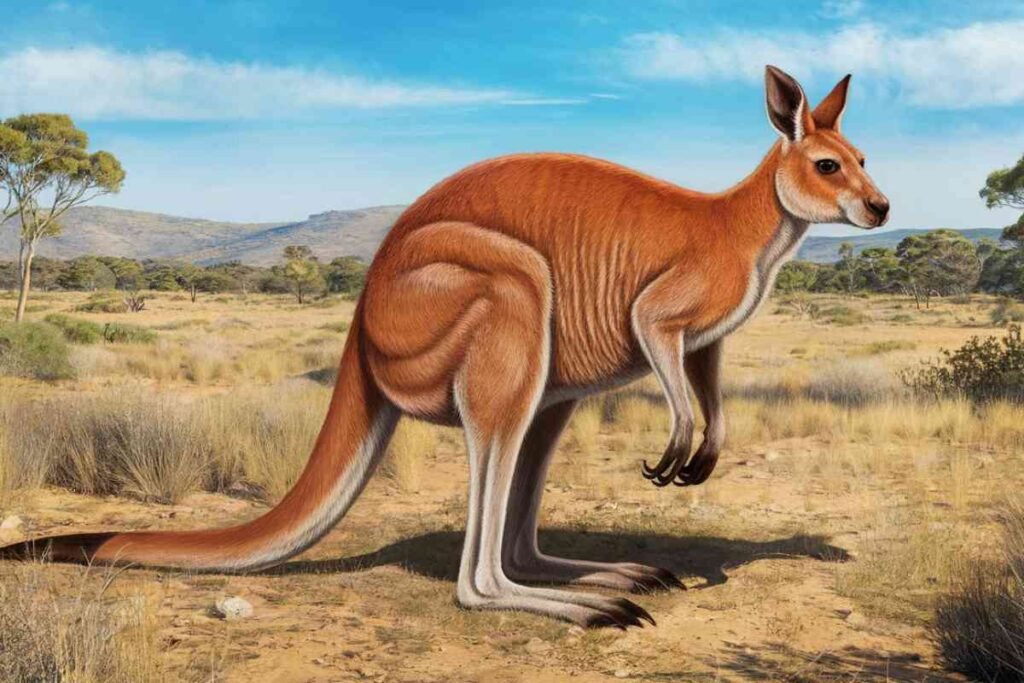The Macropus rufus, also known as the red kangaroo, is one of Australia’s most well-known and interesting animals. Famous for its large size and distinctive traits, this kangaroo represents the Australian outback.
In this article, we’ll dive into the world of the red kangaroo, covering its habitat, diet, behavior, and importance in Australia’s ecosystem.
What is the Macropus Rufus?

The Macropus rufus, commonly known as the red kangaroo, is the largest kangaroo species and one of the most well-known marsupials in the world. These iconic animals are primarily found in the vast open spaces of Australia.
Male red kangaroos, often called “boomers,” are the largest, with some growing up to 8 feet in length, including the tail. Their muscular build and powerful hind legs enable them to jump great distances, making them highly adapted to the Australian landscape.
Unique Characteristics of the Macropus Rufus
The Macropus rufus stands out due to its size, physical features, and incredible strength. Here are some unique traits that define this extraordinary species:
- Size and Strength: As the largest kangaroo species, red kangaroos can weigh up to 90 kg (200 pounds) and measure 8 feet from head to tail.
- Powerful Hind Legs: Red kangaroos are well-known for their strong hind legs, allowing them to jump distances of up to 30 feet in a single bound.
- Distinctive Appearance: Their reddish-brown fur gives them their name, and they lack the facial whiskers seen in some other kangaroo species, giving them a sleek and muscular appearance.
Habitat of the Macropus Rufus
Red kangaroos are native to Australia and thrive in the country’s dry, open areas. These animals are highly adaptable and can be found in diverse environments across the continent, from the dry deserts to the lush, open grasslands.
- Desert Regions: Red kangaroos are well-equipped to survive in the harsh desert environment. They can withstand extreme temperatures and long periods without water.
- Grasslands: In the more temperate regions, they are found in expansive grasslands where they have access to food and water during wetter seasons.
Diet and Feeding Habits
The Macropus rufus is a herbivore, primarily feeding on grasses, shrubs, and other plant-based materials found in the Australian outback. Despite their massive size, red kangaroos are able to survive on relatively little water, relying mainly on the moisture present in the vegetation they consume.
- Grasses: Their primary food source consists of grasses, which are abundant in Australia’s grassland and desert areas.
- Water Conservation: Red kangaroos can go without drinking water for long stretches by obtaining most of their hydration from the plants they eat.
Behavior and Social Structure of the Macropus Rufus

Red kangaroos are usually solitary creatures but can form groups, known as mobs, particularly when food and water are abundant. These groups generally consist of females and their young, while males are often solitary or in competition for mates.
- Jumping and Hopping: Red kangaroos are famous for their ability to travel long distances by hopping. Their powerful hind legs allow them to cover large areas while conserving energy.
- Social Mobs: While they are mostly solitary, they gather around waterholes or feeding grounds, where they interact with other kangaroos.
Reproduction and Lifespan of the Macropus Rufus
Red kangaroos have a distinctive reproductive cycle. After a gestation period of approximately 33 days, females give birth to small, underdeveloped joeys. The joey then develops further in the mother’s pouch for about 8 months before emerging and clinging to her back until it’s ready to hop on its own.
- Lifespan: Red kangaroos typically live for about 12 years in the wild, though many face threats during their early years.
Conservation Status and Threats
Though not currently considered endangered, the Macropus rufus faces numerous threats that could affect its population. The most significant threats to red kangaroos include habitat destruction, climate change, and human activity.
Discover more about conservation efforts for wildlife on our homepage
- Habitat Loss: Urban development, agriculture, and deforestation are significant contributors to habitat loss, pushing kangaroos further into the wild.
- Climate Change: Changes in weather patterns, especially prolonged droughts, have made food and water more difficult to find for red kangaroos, affecting their survival.
- Overhunting: Although the species is not endangered, overhunting and hunting for their pelts can have negative impacts on their populations.
Relationship with Humans
The red kangaroo is quite common and has even benefitted from human activities, like agriculture and the creation of waterholes. However, it faces some challenges, such as competition for food and space from livestock and rabbits.
Farmers sometimes view them as pests and may shoot them, though this is regulated in some places like Queensland and New South Wales, where a permit is required. Another issue is kangaroos crossing roads.
They often get startled by headlights or car noises, causing them to jump in front of vehicles.
This can cause serious damage to cars, especially smaller ones. The danger to drivers is higher if the kangaroo hits the windscreen. In Australia, you’ll often see “kangaroo crossing” signs to warn drivers.
The risk of kangaroo accidents is highest between 5:00 PM and 10:00 PM, particularly in the winter and after long periods of dry weather.
The Importance of the Macropus Rufus in Ecosystems

The red kangaroo plays an essential role in Australia’s ecosystem. Their grazing helps maintain the balance of plant life in their habitat, ensuring that no single plant species becomes too dominant. They also serve as prey for larger predators, contributing to the food chain’s balance.
- Ecosystem Impact: By eating grasses, red kangaroos help control plant overgrowth, which maintains healthy ecosystems.
- Cultural Significance: In Australia, the red kangaroo is not just a wildlife icon, but it also has cultural importance for Indigenous communities.
Conclusion
The Macropus rufus, or red kangaroo, is a remarkable animal that symbolizes the unique wildlife of Australia. With its impressive size, powerful abilities, and vital role in the ecosystem, this kangaroo continues to captivate those who study it and those who encounter it in the wild.
Protecting this species is crucial for maintaining the health of Australia’s ecosystems, ensuring that future generations can continue to witness the grandeur of this magnificent marsupial.
FAQs
What is the largest red kangaroo recorded in terms of size?
The largest red kangaroo ever recorded was about 8 feet long, including its tail, and weighed close to 90 kg (200 pounds).
How far can a red kangaroo jump?
Red kangaroos can jump up to 30 feet in a single bound, making them some of the most efficient movers in the animal kingdom.
Do red kangaroos live in groups?
Red kangaroos are mostly solitary, but they can form mobs, especially when resources like water or food are abundant.
How long do red kangaroos live in the wild?
In the wild, red kangaroos can live up to 12 years, though many do not survive their early years due to predators and environmental challenges.
What do red kangaroos eat?
They are herbivores, feeding mainly on grasses, shrubs, and other plant-based material they find in their environment.
Where are red kangaroos found?
Red kangaroos are native to Australia, primarily found in deserts, grasslands, and open plains across the country.
Are red kangaroos endangered?
Currently, red kangaroos are not endangered, but they face threats such as habitat destruction, climate change, and hunting.
How do red kangaroos conserve water?
Red kangaroos can survive with very little water by obtaining most of their hydration from the plants they consume.




